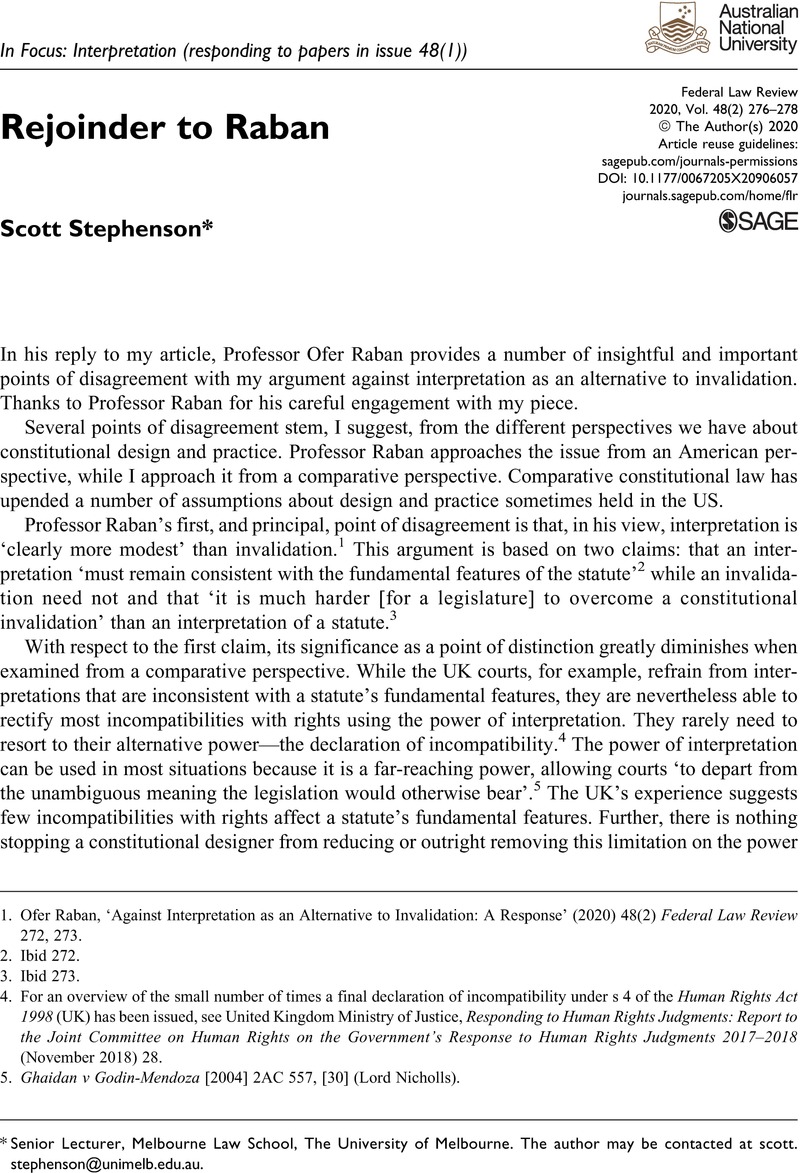No CrossRef data available.
Article contents
Rejoinder to Raban
Published online by Cambridge University Press: 01 January 2025
Abstract

- Type
- Articles
- Information
- Copyright
- Copyright © 2020 The Author(s)
References
1. Ofer Raban, ‘Against Interpretation as an Alternative to Invalidation: A Response’ (2020) 48(2) Federal Law Review 272, 273.
2. Ibid 272.
3. Ibid 273.
4. For an overview of the small number of times a final declaration of incompatibility under s 4 of the Human Rights Act 1998 (UK) has been issued, see United Kingdom Ministry of Justice, Responding to Human Rights Judgments: Report to the Joint Committee on Human Rights on the Government’s Response to Human Rights Judgments 2017–2018 (November 2018) 28.
5. Ghaidan v Godin-Mendoza [2004] 2AC 557, [30] (Lord Nicholls).
6. See generally Scott Stephenson, From Dialogue to Disagreement in Comparative Rights Constitutionalism (2016) ch 2.
7. Raban (n 1) 273. As a result, some comparative constitutional law scholars have argued that a focus on the ‘final say’ is apt to mislead: see, eg, Aileen Kavanagh, ‘A Hard Look at the Last Word’ (2015) 35(4) Oxford Journal of Legal Studies 825.
8. See, eg, Canada Act 1982 (UK) c 11, sch B pt I s 33 (‘Canadian Charter of Rights and Freedoms’).
9. Raban (n 1) 273.
10. Ibid.
11. Ibid.
12. Ibid 273–4. There appears to be no disagreement with the many other aspects of my argument beyond an ultimately unpersuasive patient metaphor: Raban (n 1) 274. The patient metaphor is unpersuasive for two reasons. First, Professor Raban admits that, ‘[w]hen we merely operate, the resulting situation is often less certain’, which is precisely my point. Interpretation produces less certainty than invalidation about the resulting situation by making it more difficult to identify, for example, what has occurred (eg, did the court merely clarify an ambiguity or rewrite the statute?). Second, a statute can be revived after a court has invalidated it (indeed, this is the exact point of a legislative override mechanism) while a patient who has been killed by a doctor cannot.
13. Ibid 274.
14. Indeed, I have argued elsewhere that many rights violations occur for precisely these reasons: Stephenson (n 6) 40–2.
15. As I state in my article, it is difficult to distinguish between interpretations that rewrite a statute and interpretations that clarify an ambiguity or fill a gap in a statute. As a result, the public will find it difficult to distinguish between situations where the legislature has deliberately limited or violated rights (a rewritten statute) and where the legislature has not (an ambiguous or incomplete statute).
16. Scott Stephenson, ‘Against Interpretation as an Alternative to Invalidation' 2020 48(1) Federal Law Review 46, 62.
17. See, eg, Scott Stephenson (n 6) chs 4, 5; Scott Stephenson, ‘Is the Commonwealth’s Approach to Rights Constitutionalism Exportable?’ (2019) 17(3) International Journal of Constitutional Law 884; Scott Stephenson, ‘Designing an Australian Bill of Rights: The Normative Trade-Offs’ in Matthew Groves, Janina Boughey and Dan Meagher (eds), The Legal Protection of Rights in Australia (Hart, 2019) 411.
18. See, eg, Vriend v Alberta [1998] 1 SCR 493.


